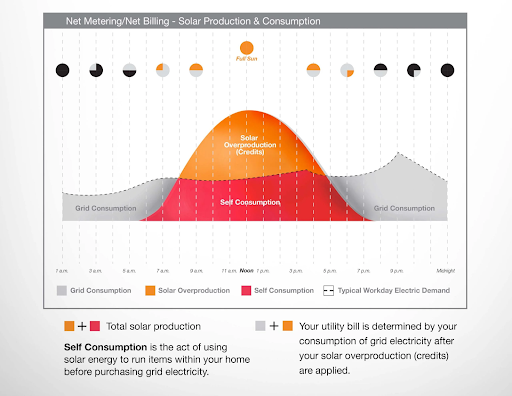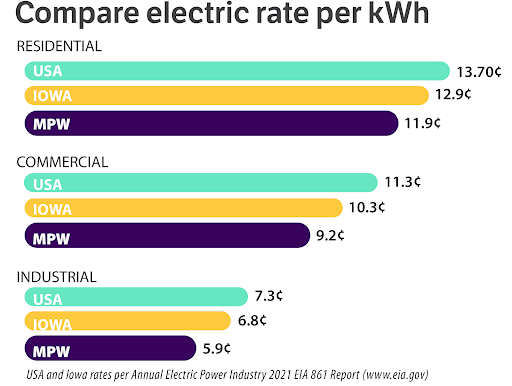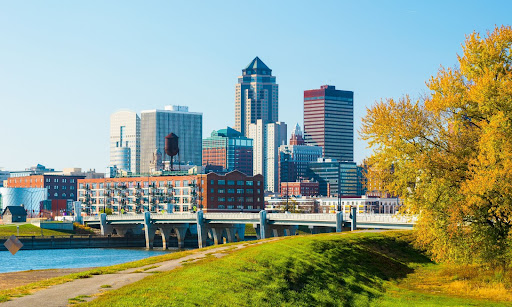Iowa Commercial Solar Incentives and Rebates
In Iowa, various incentives and savings opportunities are available for adopting solar energy, making it an attractive option for both businesses and homeowners. These incentives are designed to reduce the financial burden and accelerate the transition to renewable energy, similar to the programs in Connecticut. Here’s a detailed breakdown of these incentives:
Federal Solar Investment Tax Credit (ITC)
Overview of the Federal Solar ITC
The Federal Solar Investment Tax Credit (ITC) is a significant financial incentive in the United States that encourages the adoption of solar energy. It offers a 30% tax credit on the total cost of installing a solar photovoltaic (PV) system. This means when you install a solar energy system, you can deduct 30% of the installation cost from your federal taxes.
Eligibility Criteria
Eligibility for the ITC requires that you own the solar PV system. This includes systems purchased outright with cash or financed through a solar loan. Leased systems or those under a Power Purchase Agreement (PPA) do not qualify for the ITC.
Claiming the Tax Credit
The process involves claiming the credit when filing your federal tax return. If the tax credit is more than what you owe in taxes for that year, the excess amount can usually be carried forward to the next tax year, ensuring that you can fully benefit from the credit.
Iowa Personal Tax Credit
In addition to the Federal Solar Investment Tax Credit (ITC), Iowa provides a complementary state-level incentive to further encourage the adoption of solar energy. This incentive is a personal tax credit that equals 50% of the federal solar tax credit, effectively doubling the benefits offered by the federal program.
Tax Credit Value in Iowa
Iowa’s personal tax credit is calculated as 50% of the federal Solar Investment Tax Credit (ITC) amount. If you receive a $4,000 federal ITC, your Iowa state tax credit would be $2,000. The maximum credit available is $5,000, ensuring significant savings but with a capped benefit.
Cumulative Benefit
When the 30% federal ITC is combined with Iowa’s 50% match, the total tax credit can substantially lower the net cost of a solar installation. This combined approach makes solar energy systems more affordable, reducing the payback period and enhancing the return on investment for solar adopters.
Application Process
To claim the Iowa solar tax credit, residents must submit an application.The application should be filed by May 1st of the year following the installation. The application process typically involves providing details of the solar installation, proof of the federal ITC claim, and other relevant documentation.
Sales and Property Tax Exemption
In Iowa, a significant financial incentive for adopting solar energy is the exemption of solar equipment from sales and property taxes. This exemption applies for the first five years following the installation of the solar system.
Significant Reduction in Upfront Costs
The sales tax exemption immediately reduces the upfront cost of purchasing solar equipment, as buyers are not required to pay the standard sales tax that would typically apply. This makes solar installations more affordable, especially beneficial for more extensive or complex systems.
5 Year Fixed Property Tax
The property tax exemption ensures that the addition of solar panels does not increase a property’s assessed value for tax purposes for five years. This means homeowners and businesses won’t face higher property taxes due to their investment in solar technology during this period.
Together, these tax exemptions significantly decrease the overall cost burden of transitioning to solar energy in 52154, making it a more attractive option for both homeowners and businesses.
Local Utility Rebates
In Iowa, certain local utilities and cities offer additional incentives for solar energy system installations, supplementing state and federal programs. These local rebates are particularly noteworthy in Ames and Waverly.
Rebate by the Ames Electric Department
The Ames Electric Department provides a solar rebate program that significantly reduces the installation cost. This program offers a rebate of $300 per kilowatt (kW) of installed solar capacity, with a maximum rebate limit of $5,000. For a homeowner or business installing a solar system, this means that for each kW of solar capacity, they receive $300 back, up to a substantial $5,000 for larger systems.
State Energy Tax Credits
Iowa’s State Energy Tax Credits are designed to further encourage the adoption of solar energy systems by providing additional financial benefits to residents. This state income tax credit amounts to 18% of the installation costs of a solar energy system, with a cap of $5,000.
This credit is versatile and inclusive, as it applies not only to primary residences but also to vacation homes, existing structures, and new constructions. This wide applicability ensures that a broad range of property owners can benefit from the incentive, regardless of the type of property they are installing the solar system on.
Request a Commercial Solar Proposal for Your Iowa Business
Net-Metering in Iowa
Net metering in 50480 plays a crucial role in promoting the use of solar energy. It allows solar energy system owners to offset the cost of electricity they draw from the grid with the excess energy their systems produce. Here’s a detailed explanation:
Understanding Net Metering in 52585
Net metering in 52585 involves a single meter that monitors both the electricity delivered to and exported by an eligible distributed generation (DG) facility. The electricity generated by the DG customer offsets the electricity that would otherwise be purchased from the electric utility. This mechanism is part of Iowa’s broader efforts to encourage renewable energy use by making solar energy systems more economical and efficient for consumers.
Net Billing Method
The DG customer pays all applicable charges for the electricity delivered by the utility. The customer receives credits in kilowatt-hours for the energy exported to the electric utility during the billing period. These kilowatt-hour credits can be used to offset electricity usage in future billing periods, effectively reducing the overall electricity bills for the customer.
Inflow-Outflow Method
Similar to net billing, the customer pays all charges for the electricity received from the utility. The customer earns credits in dollars at the outflow purchase rate for energy exported to the utility during the billing period. These dollar credits can be applied to offset any volumetric charges billed on a kilowatt-hour basis in future billing periods.

Net-Metering in Iowa
Electric Utility Landscape of Iowa: A Complex Web
Remarkably, Iowa ranks among the top five states in per capita total energy consumption, largely due to its small population and large industrial sector. The industrial sector is the primary consumer of energy, accounting for more than half of the state’s total consumption. Key industries include agriculture, food production, biofuels production, and manufacturing, with major products like machinery, food and beverages, chemicals, and electronics. The transportation sector is the second-largest energy consumer, followed by the residential and commercial sectors.
Alliant Energy
Rate Increase Proposal (October 2023)
Alliant Energy filed a rate review proposing to increase 50667 customers’ electric and natural gas rates beginning in October 2024. If approved, this would result in an approximate $10 per month increase for the average residential electric customer starting in October 2024, and about $7 per month from October 2025. Additionally, the average residential gas customer’s bill would increase by about $3 per month from October 2024
Rate Review Components
Alliant Energy’s filing aims to manage future costs and meet customers’ energy needs. This includes modernizing and strengthening the energy grid, upgrading infrastructure, and diversifying their energy mix with renewables, including 400 megawatts of solar. These efforts contribute to greater customer value and energy system resilience
Black Hills Energy
Rate Increase Proposal
Black Hills Energy proposed a rate increase to recover cost increases and over $250 million of investments in the natural gas system. This includes pipeline replacement and reliability projects, which contribute to safety and greenhouse gas emission reduction
Temporary Rate Increase
A temporary rate increase of approximately 8.6% was implemented effective June 11, 2023. For the average residential customer using 63 therms of energy a month, this translated to an increase of approximately $0.05 per month. The final rates, pending approval, may result in refunds for customers.
Proposed Rate Impact
If the rate request is approved, the typical residential customer’s bill would increase by $2.02 a month. The impact on commercial, industrial,governmental customers and even schools relying on utility electric supply will vary based on their energy demand and usage.
General Electricity Cost in Iowa
In Iowa, the general cost of electricity can be understood through average billing amounts and energy usage rates. As of 2023:
- Average Monthly Cost: Iowa residents spend about $138 per month on electricity, which adds up to $1,656 annually. This amount is 25% lower than the national average electric bill of $2,193.
- Average Electric Rate: The average electric rate in Iowa is approximately 14 cents per kilowatt-hour (¢/kWh).
- Average Monthly Consumption: The average electricity customer in Iowa uses about 995 kWh of electricity per month, and around 11,940 kWh over the course of a year.
Electric bills in Iowa are composed of both fixed charges (such as monthly customer charges) and variable charges (¢/kWh used). While fixed charges remain the same each month, variable charges change based on electricity usage. Two primary ways to reduce bills include using less electricity or reducing the cost of electricity, for example, by installing solar panels.

Electricity Cost in Iowa
Is Solar Worth It in Iowa?
Return on Investment (ROI)
When evaluating the Return on Investment (ROI) for solar installations in 50123, two critical aspects need to be considered: the balance between initial investment and long-term savings, and the impact on property values.
The initial cost of installing a solar system, which includes the price of solar panels, inverters, mounting equipment, and installation labor, can be substantial. However, this upfront investment is mitigated over time through significant long-term savings. These savings primarily come from reduced energy bills. With the average electric rate in Iowa around 14 cents per kWh, and the potential for higher rates in the future, the amount saved on electricity can be considerable, especially over the lifespan of the solar system, which is typically 25 to 30 years. Additionally, the financial incentives available in Iowa, such as the Federal Solar Investment Tax Credit and the state’s own tax credit, reduce the effective cost of installation, thereby improving the ROI.
Solar Energy Feasibility in Iowa
The potential for solar energy generation in 52146 is significantly influenced by its climate and advancements in solar technology. The state experiences a considerable number of sunny days throughout the year, creating an ideal environment for solar energy production. This consistent solar irradiance is a key factor in determining the effectiveness and viability of solar power systems. Regions with higher sunlight exposure naturally yield more electricity from solar panels, making solar investments more attractive and practical.
Further enhancing the feasibility of solar energy is the technological advancements in the solar industry. Modern solar panels are more efficient than ever, capable of converting a higher percentage of sunlight into electricity. This increased efficiency means that even on days with less than optimal sunlight, such as during cloudy weather, solar panels can still generate a significant amount of energy. Additionally, technological improvements have also led to more durable and long-lasting solar panels, ensuring that they can withstand varying weather conditions typical in Iowa, like snow and rain.
Iowa: The Heart of the United States
Iowa, a state located in the heart of the American Midwest, is known for its picturesque landscapes and rich cultural heritage. The state capital, Des Moines, serves as the economic and cultural hub, housing significant landmarks like the grand Iowa State Capitol Building and the Des Moines Art Center, celebrated for its extensive collection of contemporary art. Further east along the Mississippi River is the city of Dubuque, home to the National Mississippi River Museum and Aquarium, a facility dedicated to the conservation of America’s river systems and aquatic life, offering interactive and educational experiences.
Another notable destination is the Amana Colonies near Iowa City, a National Historic Landmark comprising seven villages that reflect the unique German Pietist heritage of the region. These colonies are a window into 19th-century communal living, known for their traditional craft shops and restaurants. In Dyersville lies the iconic Field of Dreams Movie Site, a pilgrimage spot for movie enthusiasts and baseball fans, immortalized by the 1989 film.
Iowa also boasts a connection to presidential history with the Herbert Hoover National Historic Site in West Branch. This site honors the life of the 31st President of the United States, featuring his birthplace cottage, a presidential library, and museum. In West Bend, visitors can explore the Grotto of the Redemption, an extraordinary religious shrine known as the “Eighth Wonder of the World,” featuring grottos made from precious stones and gems depicting scenes from the life of Jesus Christ.
For nature lovers, the Maquoketa Caves State Park in Maquoketa offers a stunning display of natural cave formations and hiking trails, making it a popular spot for outdoor activities. Lastly, the Iowa Great Lakes in the northwest region of the state, including Spirit Lake and the Okoboji Lakes, are renowned for their natural beauty and offer a plethora of recreational activities, drawing visitors year-round.

Iowa City, Iowa
Why choose Commercial Solar for your commercial solar project in Iowa?
Choosing Commercial Solar for a commercial solar project is a strategic decision that aligns with both financial prudence and environmental stewardship. Commercial Solar brings to the table a wealth of expertise in solar technology, ensuring that each project is not only about installing solar panels but also about integrating sustainable energy practices into the core operations of a business.
Customized Solutions
We specialize in providing bespoke solar solutions that align with the unique needs and goals of each business, guaranteeing optimal efficiency and ROI.
Environmental Impact
Collaborating with Commercial Solar aids in achieving environmental sustainability by lowering the carbon footprint and fostering eco-friendly practices.
Financial Incentives and Assistance
Commercial Solar offers guidance in leveraging various state and federal incentives to enhance your business’s financial gains.
Continuous Support and Maintenance
With a commitment to enduring service, Commercial Solar ensures the consistent efficiency and dependability of your solar installation over time.
Transition to a Greener Future with Commercial Solar
At Commercial Solar, we are committed to more than just installing solar panels; our aim is to shape a greener, more sustainable tomorrow for Connecticut. Our experienced team stands ready to guide you through each step of adopting solar energy. Contact us to learn how incorporating solar power can revolutionize your business, playing a vital role in Connecticut’s journey towards ecological sustainability and progress.
Other Information |
|
| Areas Serving And Zip Codes: | Des Moines, Cedar Rapids, Davenport, Sioux City, Iowa City, West Des Moines, Ankeny, Waterloo, Ames, Council Bluffs, Dubuque, Urbandale, Marion, Cedar Falls, Bettendorf, Marshalltown
50309, 52227, 52722, 51054, 52240, 50061, 50021, 50701, 50010, 51501, 52001, 50111, 52302, 50613, 52807, 50158 |
|---|---|
| Services | Commercial Solar Installation
|
| Company Logo: |  |